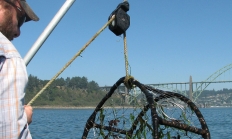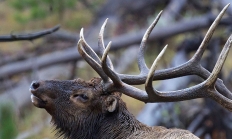
Search myodfw.com

W hen it comes to calling turkeys in the spring , we ’re being a bit unnatural. In the turkey woods, toms gather on strutting grounds and try to call hens to them. Hunters are doing just the opposite: making hen sounds to bring toms to them. For this reason, it pays to develop confident turkey calling skills. Here ’s a look at the turkey sounds hunters will want to be able to make. Refer to the instructions for each kind of call to see how to mimic these sounds. The yelp is a basic turkey call and the easiest



Give space to elk and deer - calf and fawn season is here
Beth Quillian, beth.s.quillian@odfw.oregon.gov, (503) 804-0841
SALEM, Ore. – Oregon's deer and elk give birth from May through July each year. It's natural for mother animals to leave their young alone for extended periods of time while they go off to feed. If you come across a fawn or calf by itself, don't assume it's orphaned. The mother is likely nearby and will return once the area is free of people, pets, or predators.
ODFW regularly receives calls from well-intentioned people who have picked up a fawn thinking it was abandoned or orphaned. What does ODFW tell them? Put it back where you found it.
When people remove them from the wild, young animals miss the chance to learn where to seek cover, what to eat and how to escape from predators and other dangers. The time young animals spend with their parents and in their natural environment is crucial for the development of their long-term survival skills.
Removing an animal from the wild is also a violation of Oregon wildlife laws. (ORS 497.308 – No person shall remove from its natural habitat or acquire and hold in captivity any live wildlife in violation of the wildlife laws.)
Fawns and calves are most vulnerable to predators in their first few weeks of life when they can't keep up with the adults. To avoid calling attention to their offspring, mothers will hide their young in brush and leave to forage for food, sometimes for long periods. A fawn or calf's spotted coat helps camouflage them as they stay motionless. They also have very little odor as another protection against attracting predators.
Picking up wildlife causes more harm than good If you see a fawn alone, leave it where it is - its mother is likely nearby. The hard truth is that removing a fawn from the wild almost immediately reduces its chances of survival to zero. Deer do not abandon their fawns. A doe invests months of energy into raising her young and will go to great lengths to find her fawn when she returns from foraging, often searching the area extensively.
If you encounter deer or elk, especially with young, give them space and enjoy viewing from a distance. If your presence disturbs wildlife, you're too close.
Keep pets leashed and away from wildlife Deer and elk see dogs as a threat and may respond aggressively to protect their young. Female elk with young calves have injured and killed pets in Oregon and Washington. It is their instinct to protect their young.
Roosevelt elk are the largest elk subspecies in terms of body size, with bulls generally weighing 700-1,100 pounds. Cow elk will aggressively protect their young in the spring and summer. Bull elk become especially aggressive during the fall rut when they challenge other males and will charge anything that comes too close.
Chris Kern, Region Manager Fisher research in southern Oregon Fisher are a Species of Greatest Conservaion Need in Oregon's State Wildlife Action Plan, and ODFW is actively conducting research to understand fisher occupancy and distribution east of I-5, as well as that of their competitors and predators. Wildlife Research staff maintained 30 baited camera traps in the Cascade-Siskiyou National Monument and Southern Cascades. The cameras were deployed in mid-September on U.S. Forest Service and Bureau of Land Management lands in areas with proposed habitat management efforts. The goal is to evaluate how these land alterations influence changes in mesocarnivore occupancy




Turkey anatomy plays a big part in determining shot placement with a bow. Knowing where vital organs like the heart and lungs are will help you make a clean shot. Sometime getting to the vital organs may mean going through bone. In fact, a shot to the spine will drop a turkey quickly. But turkey bones are very strong, despite being hollow. That’s why many experienced archers prefer shooting a bow with a heavy draw weight, often the same setup they use for deer and elk hunting. Head shots, the most popular turkey shot for shotgun hunters, should be avoided



Build a wood duck house to encourage nesting. Walk a stream counting steelhead redds. Teach families to fish. Just some of the things ODFW volunteers do to help protect and enhance Oregon's natural resources. Current volunteer opportunities


Whether it's concerns about your local fishery, questions about an upcoming hunt, or comments about an agency policy, we want to hear from you. Please feel free to call or send us an e-mail.


Nick Myatt, Region Manager Golden eagle research in northeast District wildlife staff in Wallowa County, in partnership with the U.S. Fish and Wildlife Service and the Nature Conservancy, began a pilot project to study the survival, movement, and reproductive success of golden eagles. During the pilot phase, ODFW staff tested methods of capture as well as telemetry units to determine feasibility for a longer-term study. The first capture event during this pilot project took place in mid-December 2024. USFWS provided four GPS units for this pilot year. The data from golden eagles captured in northeast Oregon during this pilot phase



